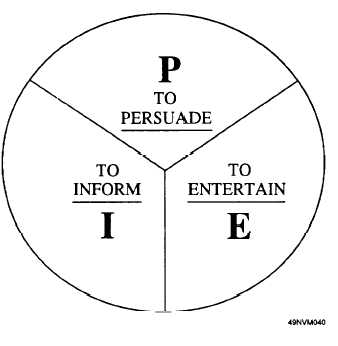| |
Figure 7-4.–The three purposes of public speaking.
Informative Speeches
Informative speeches are meant to give the
audience new or additional information on a relative
subject. Sea Power presentations would qualify for
informative speeches. A speech to local educators
on educational opportunities in the Navy would be
another example of an informative speech.
Entertaining Speeches
Entertaining speeches are meant to amuse the
audience and provide enjoyment. Rarely is this
purpose used alone.
In the area of recruiting,
entertainment will be secondary to one of the other
purposes of public speaking. Acknowledging it as a
secondary purpose to your speech can have obvious
benefits. People normally will pay closer attention
to a speech that also provides some enjoyment.
FACTORS TO CONSIDER -
PREPARATION
Before setting pen to paper to start your speech
preparation, there are several considerations you
will want to make. Your point of contact should be
able to provide information as to type of speech
expected, your audience composition, and physical
surroundings.
Know Your Audience
It is important to know a little bit about the
people who will be listening to your speech. What
are their needs and interests? What is their current
knowledge and experience level?
Background
information can be very helpful when preparing the
speech. You want to prepare your speech on their
level and be able to relate your topic to things they
already
understand or
are
interested in.
Personalization is
a
key
ingredient
to
public-speaking success.
Physical Surroundings
It is also important to know what your physical
surrounding will entail. If at all possible, you should
make a visit beforehand to the room where you will
be speaking. Note lighting conditions, acoustics, the
size of the space, and available equipment. Taking
this time to ensure the surroundings will be
adequate can prevent some embarrassing surprises
later.
KEY POINT OUTLINE
Now you are ready to develop your speech. The
easiest way to organize a speech is with a key point
outline, which includes the parts of a short speech:
the introduction, the body or presentation, and the
conclusion or close.
By writing only a key point
outline, you avoid the tendency to read your speech.
You appear to speak almost extemporaneously, but
in reality your outline makes it seem that you are
well prepared.
Introduction
The introduction
should start with an
appropriate greeting to your audience. You should
then introduce yourself and your topic. Give a brief
history of your background to credentialize yourself.
To complete the introduction, you need an attention
getter of some sort. Some people like to use a joke
or humorous anecdote that correlates with their
topic. You may just want to let them know
why the topic is important to them.
Another
attention-getting technique is to ask a rhetorical
question that you will answer in your presentation.
Body or Presentation
This is the part of your speech that delivers the
information you have planned for the audience to
7-16
|

